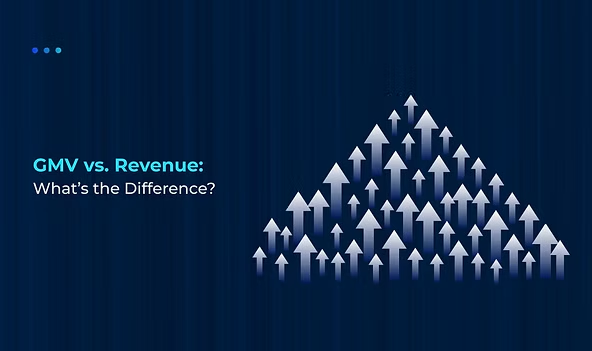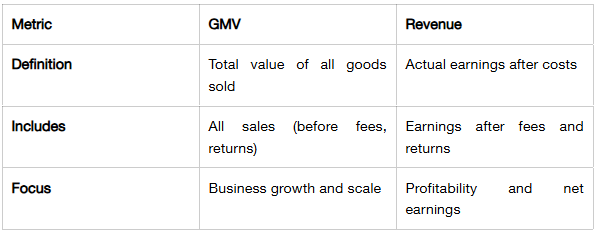
Measuring success for your eCommerce business is no longer a simple aspect. As more platforms, data sources, and variables are coming in, relying on traditional metrics like revenue alone doesn’t cut it anymore. In order to remain competitive, your business KPIs should change per the complex realities of the online business.
In this blog, we will focus on two main metrics, which are the Gross Merchandise Value (GMV) and the Revenue.
We will discuss the importance of GMV, the difference between GMV and Revenue, and why it is more important and needs your focus to evaluate the performance of the eCommerce business.
What is GMV and Why Is It Important?
GMV vs. Revenue: What’s the Difference?
Use GMV Data In Order To Achieve Better Results
GMV or Gross Merchandise Value represents the value of all merchandise transactions that have been performed by your site within a specific period.
Unlike revenue, GMV doesn’t account for discounts, returns, or fees. GMV presents the gross sales performance of your business from a top-line perspective.
The understanding of GMV has a number of benefits to eCommerce organizations:
GMV consolidates all factors/variables of sales including any that may not be concerned with revenue generation at the moment. This helps you observe customer spending across your entire range of services.
When the GMV is large, it is often a sign, and in most cases, it relates to the fact that the business is expanding. Understanding this measure further enables one to ascertain the possible estimation of what is to come and detect interesting movements.
You can monitor each GMV that comes after marketing. This indicates how improvement in GMV level was a consequence of an expansion strategy deemed effective.
For a detailed breakdown of why GMV should be prioritized, check out this guide from Graas.

Measuring GMV over revenue is essential, especially in eCommerce, because revenue formulas vary across platforms like Shopee, Lazada, TikTok, and Amazon. Each platform has different fee structures, discounts, and return policies which makes it difficult to get an apples-to-apples comparison of revenue across your business.
Below is a table explaining how each marketplace calculates revenue:

GMV provides a comprehensive overview of the total sales made regardless of the various types of deductions and fees that may be incurred in sales recording. You will have a better and more reliable means of knowing how fast your business is growing.
GMV is of great importance, but it is by no means the last measure. Try to track these additional KPIs:
If you want to attain long-term growth in increasing your eCommerce activities, then use the GMV data as a decision-making point. The following are some of the ways how GMV data can be used to help an organization:
To ensure that the data works well for you, an eCommerce analytics tool is definitely an integral part. It is going to help you:
Measuring GMV gives a more comprehensive and deeper understanding of the performance of your eCommerce operations. Understandably revenue is important, but GMV provides the data and information required to grow, refine processes, and manage operations within a planned framework.
That’s exactly what Graas does.
Graas uses Gross Merchandise Value (GMV) to give you a bigger picture of how your products are performing. By focusing on GMV, you can get a better sense of how much demand there is for your products and track how your sales are growing over time.
If you’re looking to consolidate all your eCommerce data into a unified platform that can give you in-depth analytics and data-backed insights and recommendations, look no further. For a single source of truth, try Graas.